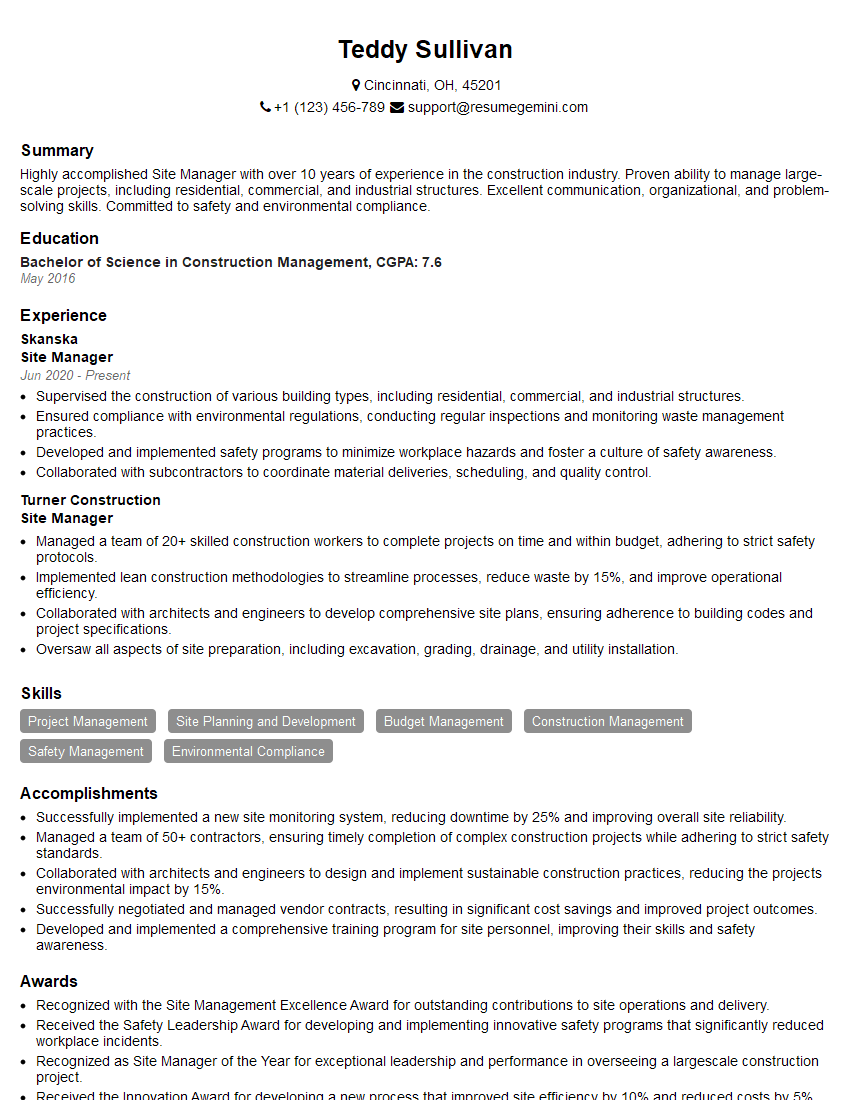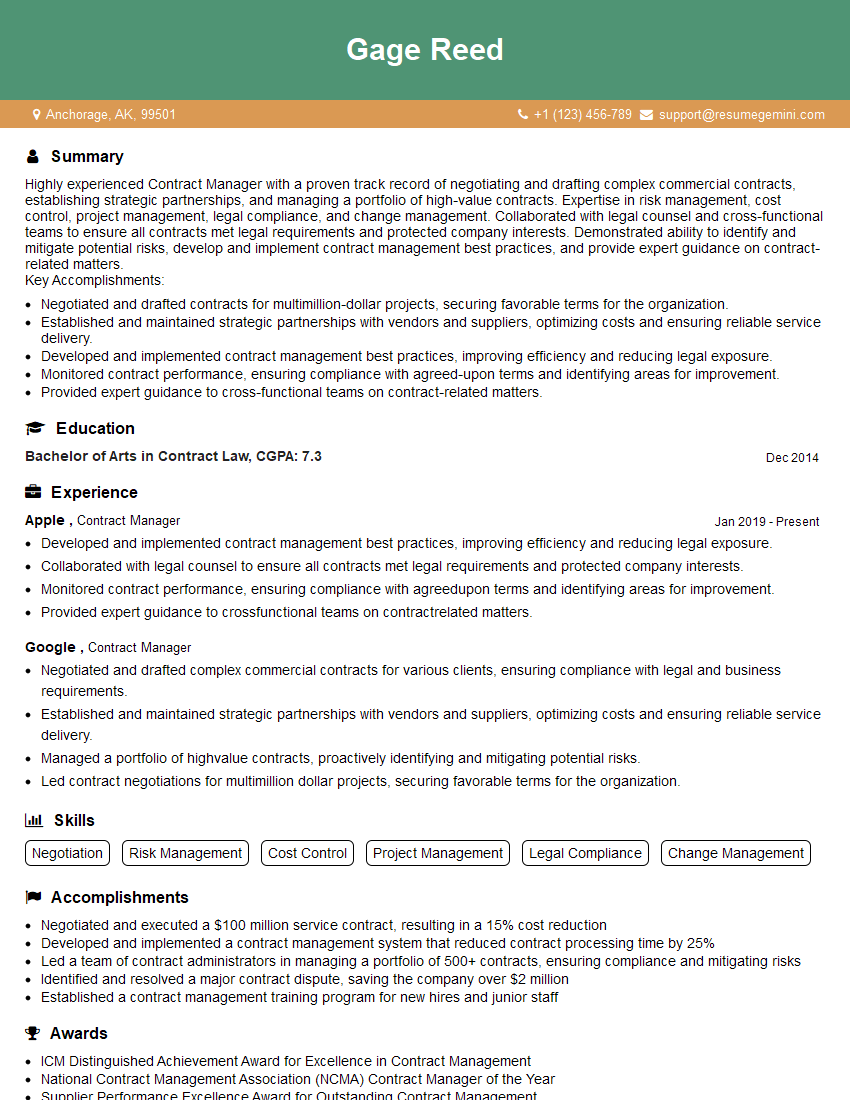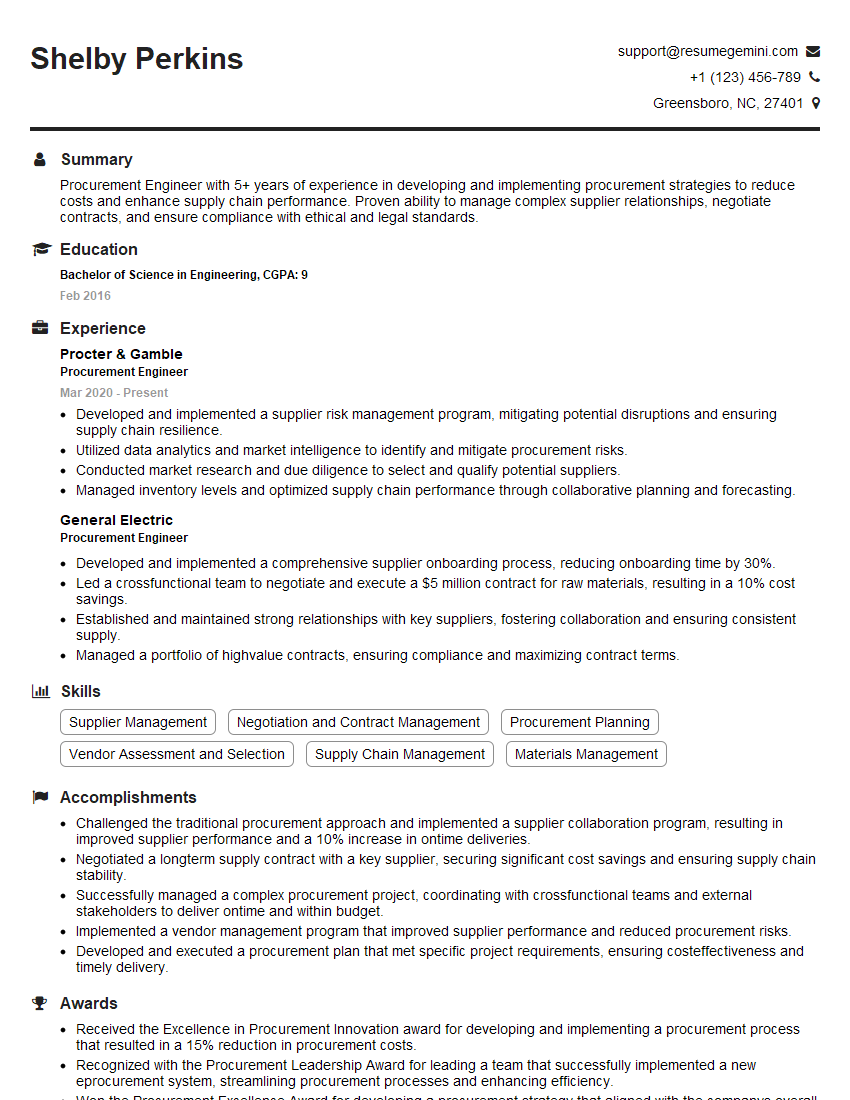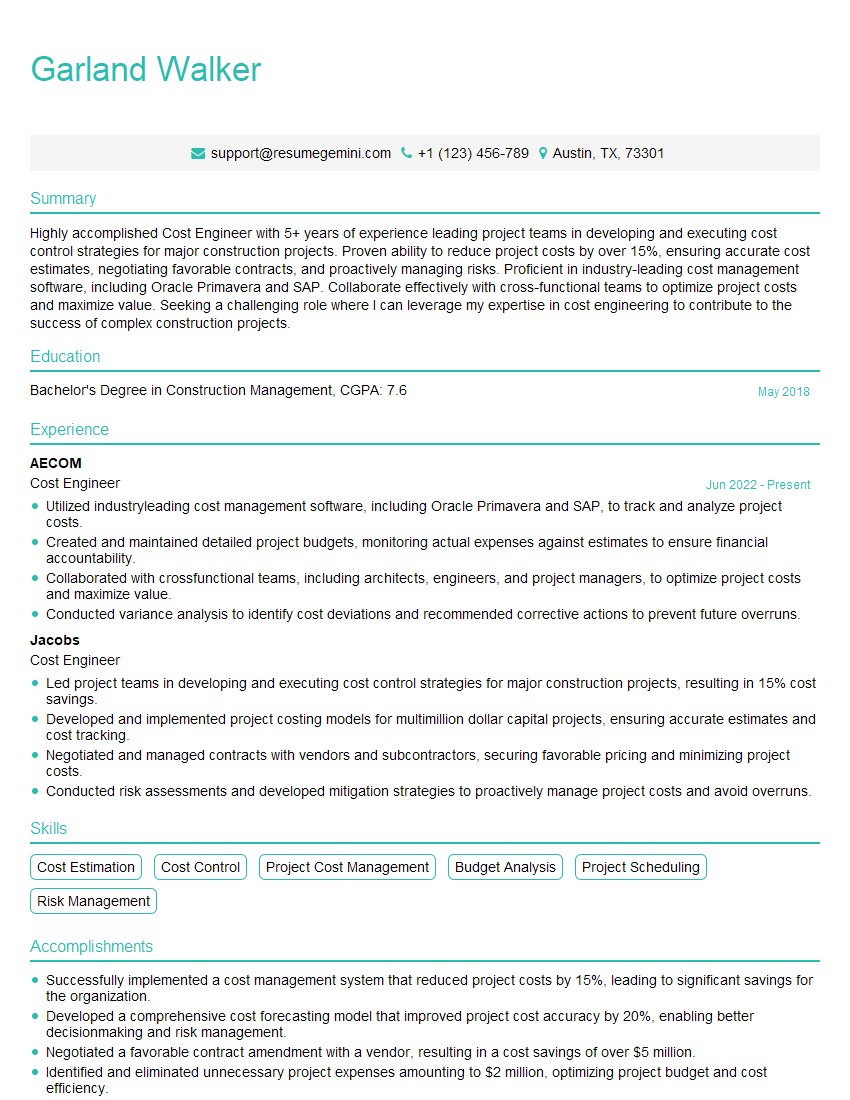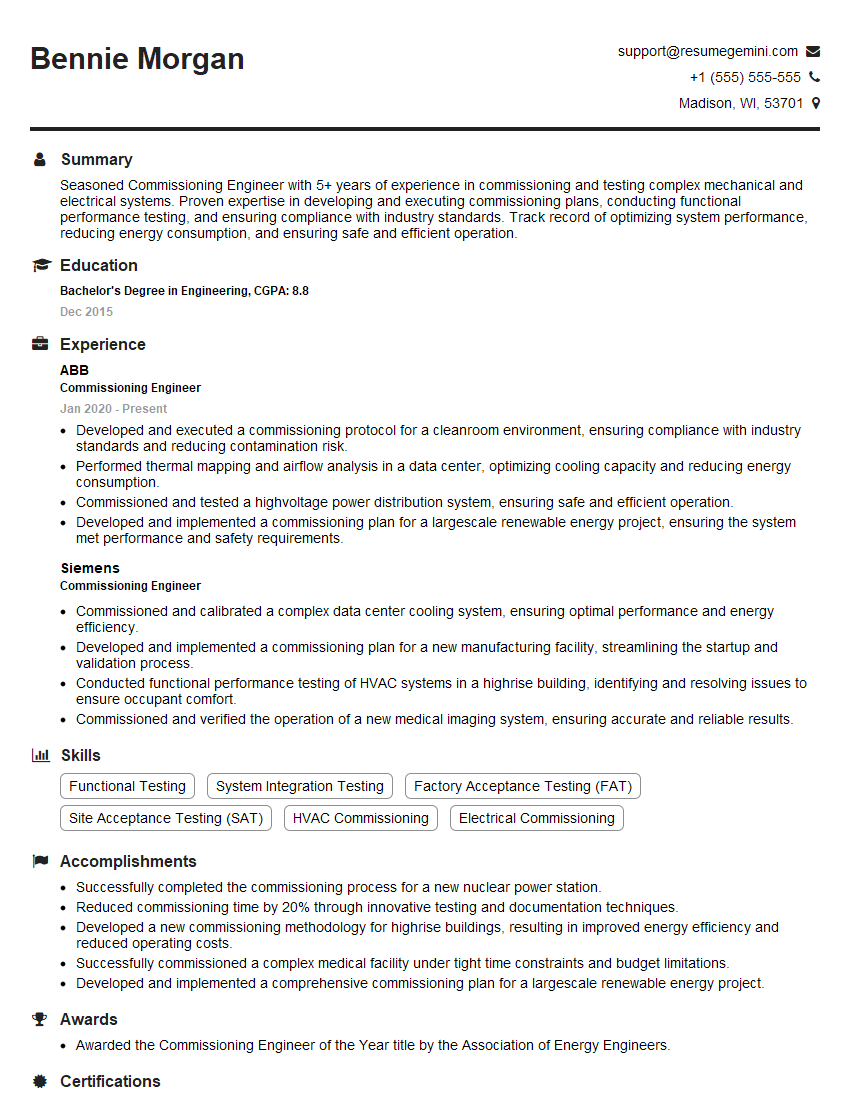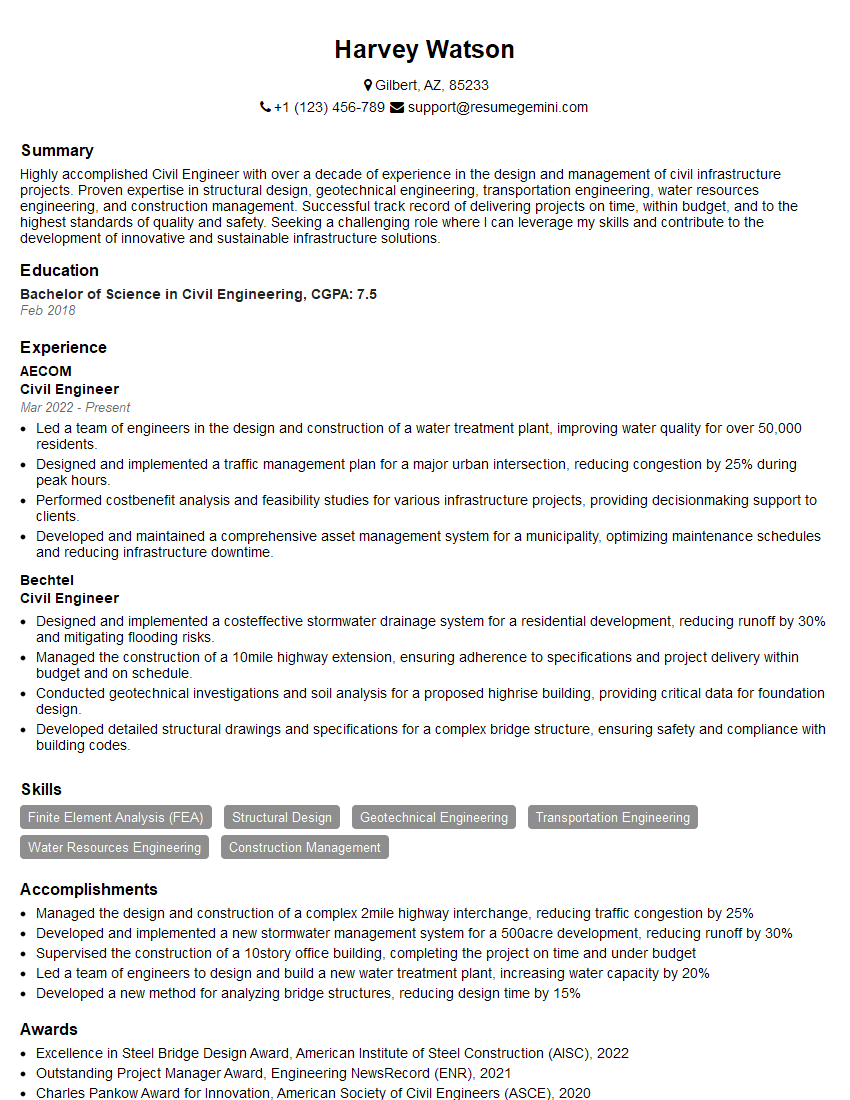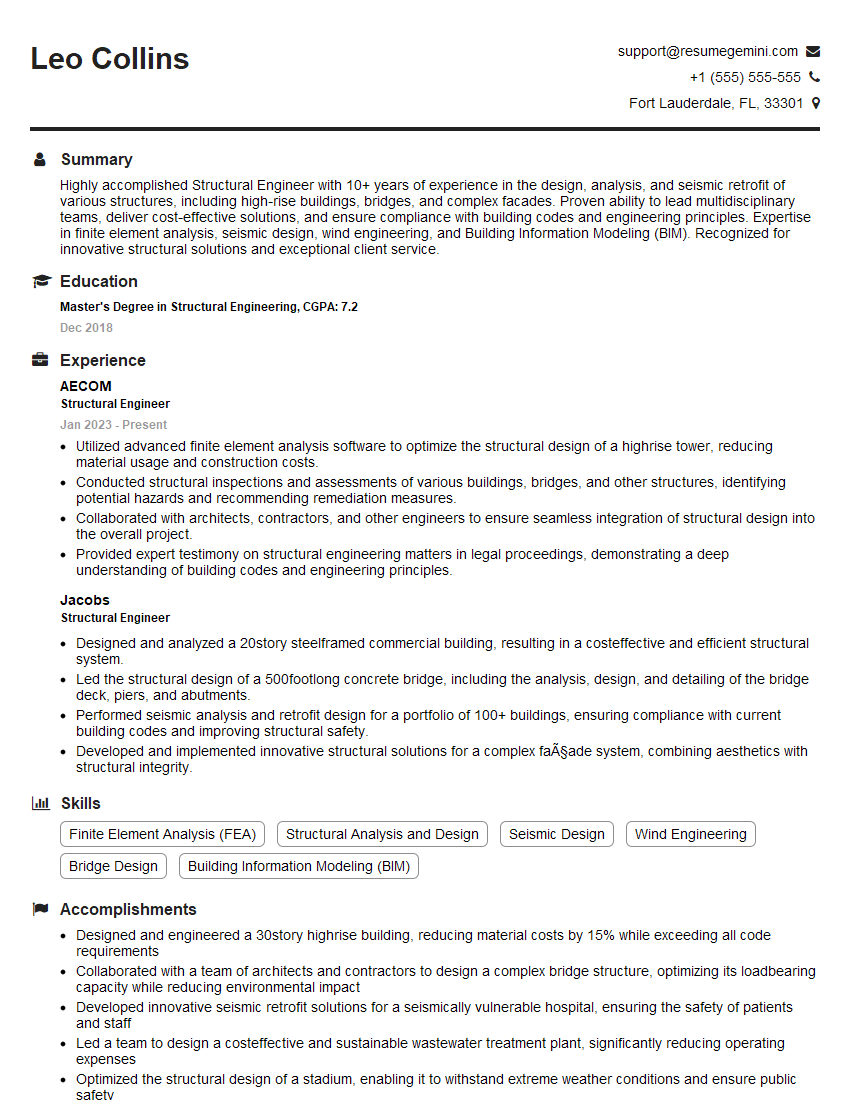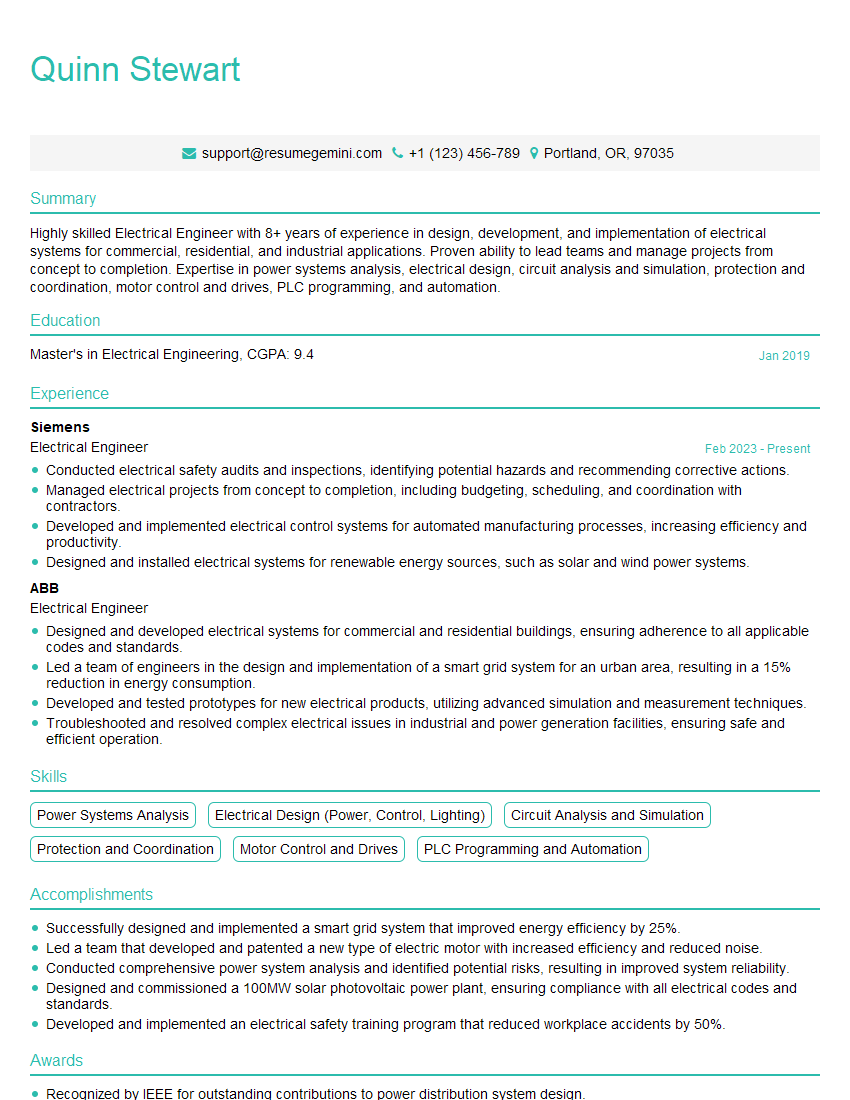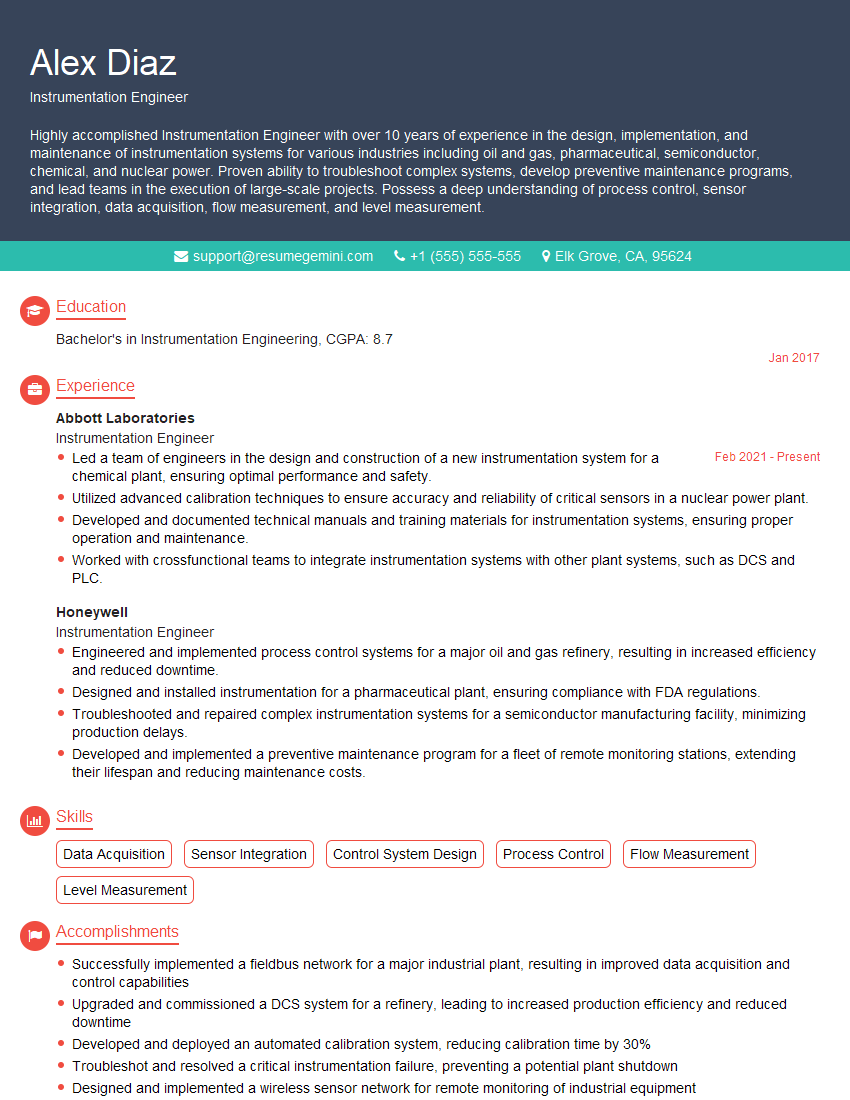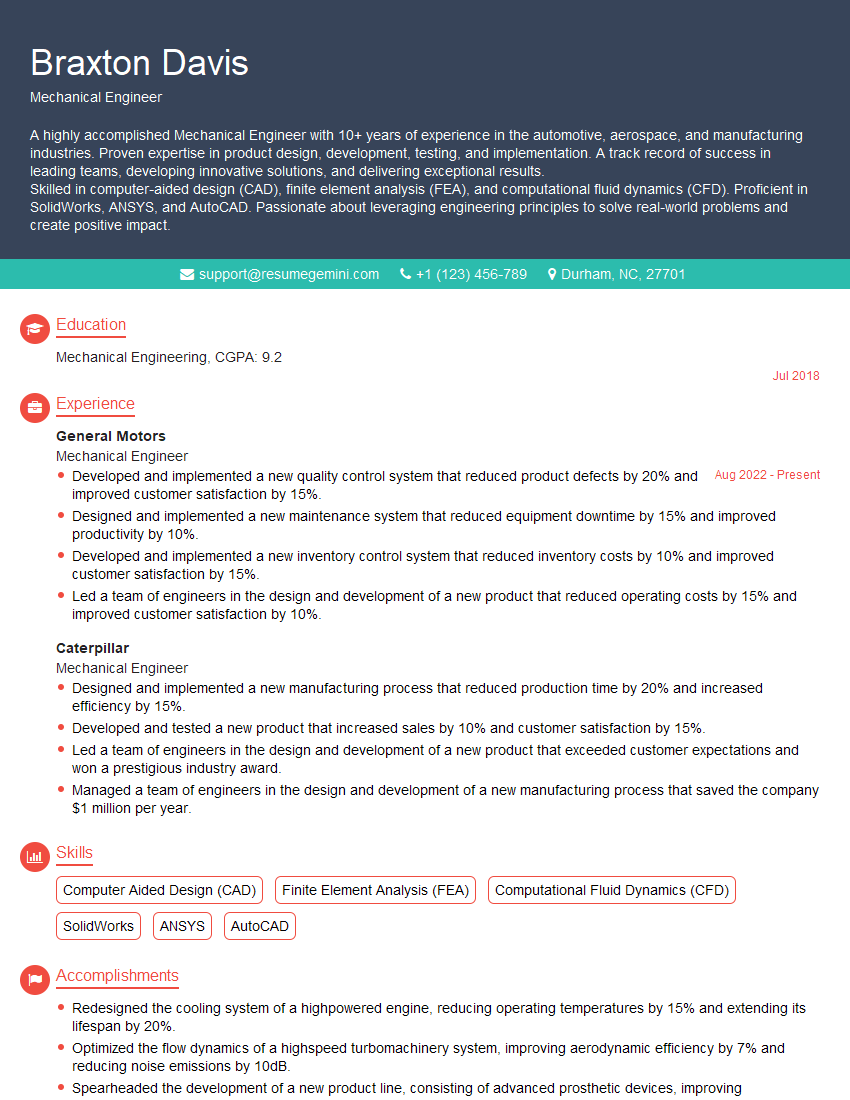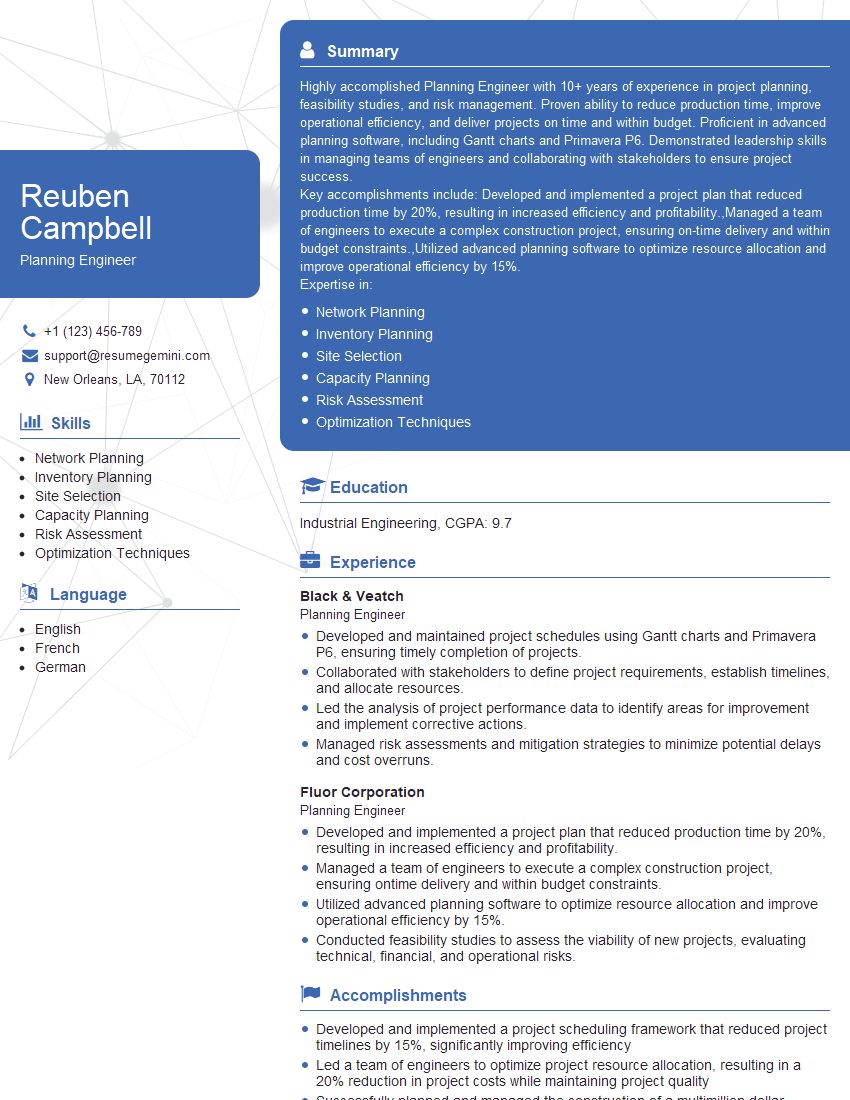Interviews are opportunities to demonstrate your expertise, and this guide is here to help you shine. Explore the essential Chemical Plant Construction interview questions that employers frequently ask, paired with strategies for crafting responses that set you apart from the competition.
Questions Asked in Chemical Plant Construction Interview
Q 1. Explain your experience with different types of chemical plant construction projects.
My experience encompasses a wide range of chemical plant construction projects, from small-scale modifications and upgrades to large-scale, complex new builds. I’ve worked on projects involving various chemical processes, including petrochemical refining, pharmaceutical manufacturing, fertilizer production, and specialty chemical synthesis. This has given me a deep understanding of the unique challenges and requirements associated with each process type. For instance, a pharmaceutical plant requires significantly stricter cleanliness and sterility protocols compared to a fertilizer plant. I’ve also been involved in projects utilizing diverse materials, such as stainless steel, carbon steel, and specialized alloys, each demanding a specific approach to construction and welding.
- Petrochemical Refining: Worked on a project expanding the capacity of a fluid catalytic cracking unit, requiring precise engineering and meticulous safety protocols due to the high-temperature, high-pressure environment.
- Pharmaceutical Manufacturing: Oversaw the construction of a new aseptic filling line, demanding strict adherence to cGMP (current Good Manufacturing Practices) and validation procedures.
- Fertilizer Production: Managed the construction of a new ammonia synthesis plant, focusing on safety measures to mitigate risks associated with handling hazardous materials like ammonia.
Q 2. Describe your familiarity with various construction methodologies (e.g., EPC, design-build).
I’m proficient in various construction methodologies, with extensive experience in both Engineering, Procurement, and Construction (EPC) and Design-Build approaches. EPC involves a single contractor responsible for engineering, procurement, and construction, offering a streamlined approach with clear lines of responsibility. Design-Build integrates design and construction under a single contract, potentially leading to faster project completion and cost savings. My experience allows me to choose the most suitable methodology based on the project’s specifics, considering factors like complexity, budget, and timeline.
For example, on a fast-track project with a tight budget, a Design-Build approach might be favored for its efficiency. Conversely, for a highly complex project requiring specialized engineering expertise, an EPC approach might be more appropriate to ensure seamless integration and quality control. I also have experience with other methods like Construction Management at Risk (CMAR), offering flexibility and managing subcontractors effectively.
Q 3. How do you ensure compliance with safety regulations during chemical plant construction?
Safety is paramount in chemical plant construction. My approach involves a multi-layered strategy, starting with a comprehensive safety plan developed in the initial design phase and strictly enforced throughout the project lifecycle. This plan incorporates:
- Hazard Identification and Risk Assessment (HIRA): Identifying potential hazards and implementing control measures to mitigate risks.
- Regular Safety Inspections and Audits: Conducting routine checks to ensure compliance with safety regulations and best practices.
- Safety Training Programs: Providing comprehensive training to all personnel on site-specific hazards and safety procedures.
- Emergency Response Plans: Establishing clear protocols for handling emergencies, including fire, spills, and medical situations.
- Personal Protective Equipment (PPE): Ensuring all personnel use appropriate PPE.
- Compliance with OSHA and other relevant regulations: Rigorous adherence to all applicable safety regulations and standards.
For instance, during the construction of a chemical storage facility, we employed strict lockout/tagout procedures to prevent accidental releases during maintenance activities. Each step of the project was rigorously reviewed for compliance and safety improvements.
Q 4. What are your strategies for managing project schedules and budgets effectively?
Effective project management is crucial in chemical plant construction. I use a combination of tools and techniques to ensure projects are completed on time and within budget. This includes:
- Detailed Project Scheduling: Utilizing critical path method (CPM) scheduling software to identify critical tasks and manage dependencies.
- Resource Allocation and Management: Optimizing resource allocation to ensure efficient workflow and prevent bottlenecks.
- Cost Control and Budgeting: Implementing robust cost control measures, regular budget reviews and variance analysis to identify and address potential cost overruns.
- Progress Monitoring and Reporting: Regular progress tracking and reporting to stakeholders using Earned Value Management (EVM) techniques.
- Change Management: A formal process for managing changes to the project scope, schedule, or budget.
For example, on a recent project, we proactively identified potential delays due to material supply chain issues and implemented contingency plans to mitigate the impact on the overall schedule and budget.
Q 5. Explain your experience with risk assessment and mitigation in chemical plant construction.
Risk assessment and mitigation are integral to successful chemical plant construction. My approach involves a proactive and systematic process:
- Qualitative Risk Assessment: Identifying potential risks through brainstorming sessions, HAZOP studies (discussed in the next answer), and checklists.
- Quantitative Risk Assessment: Analyzing the likelihood and consequences of identified risks to determine their potential impact on the project.
- Risk Mitigation Strategies: Developing strategies to mitigate identified risks, including risk avoidance, risk reduction, risk transfer, and risk acceptance.
- Risk Monitoring and Control: Continuously monitoring risks throughout the project lifecycle and adjusting mitigation strategies as needed.
For example, during the construction of a reactor vessel, we identified a risk of cracking due to high internal pressures. To mitigate this, we implemented enhanced quality control measures during fabrication and employed non-destructive testing techniques to verify the integrity of the vessel.
Q 6. Describe your knowledge of HAZOP studies and their application.
HAZOP (Hazard and Operability) studies are a systematic technique used to identify potential hazards and operability problems in chemical processes. I’m highly experienced in conducting and facilitating HAZOP studies, utilizing a structured approach involving a multidisciplinary team to review process flow diagrams (PFDs) and process and instrumentation diagrams (P&IDs). The team systematically considers deviations from the design intent (e.g., ‘higher pressure,’ ‘lower temperature,’ ‘no flow’), and assesses the potential consequences of these deviations. This results in a comprehensive list of identified hazards and recommendations for mitigation measures.
For example, during a HAZOP study for a distillation column, we identified a potential hazard of a pressure surge due to a blocked line. The study led to the recommendation of installing a pressure relief valve and additional instrumentation for early warning detection.
Q 7. How do you handle unexpected challenges or delays during a project?
Unexpected challenges and delays are inevitable in complex projects like chemical plant construction. My approach focuses on proactive problem-solving and effective communication:
- Immediate Assessment: Quickly assess the nature and extent of the challenge, gathering all relevant information.
- Root Cause Analysis: Identify the root cause of the delay or challenge to prevent recurrence.
- Develop and Implement Mitigation Strategies: Work collaboratively with the project team to develop and implement effective mitigation strategies.
- Communication and Transparency: Keep all stakeholders informed of the situation, proposed solutions, and potential impact on the project.
- Documentation: Maintain thorough documentation of the challenge, mitigation actions, and outcomes.
For example, if a critical piece of equipment is delayed, I would explore alternatives, such as procuring a substitute, accelerating the fabrication process, or adjusting the project schedule to accommodate the delay while minimizing the overall impact.
Q 8. What software programs are you proficient in for chemical plant design and construction?
My proficiency in software for chemical plant design and construction spans several key programs. I’m highly skilled in AutoCAD for detailed 2D and 3D plant layouts, including piping and equipment placement. I also have extensive experience with Autodesk Plant 3D, a powerful tool for creating intelligent 3D models, managing components, and generating comprehensive documentation. For process simulation and optimization, I’m proficient in Aspen Plus and ChemCAD. Finally, I utilize Microsoft Project for effective project scheduling and resource allocation, ensuring projects remain on track and within budget.
For example, on a recent project involving a petrochemical refinery expansion, I leveraged Autodesk Plant 3D to create a highly accurate 3D model, identifying potential clashes and optimizing piping routes before construction even began, significantly reducing costly rework later. My proficiency in Aspen Plus allowed us to model various process scenarios and optimize the plant’s efficiency.
Q 9. Explain your understanding of piping and instrumentation diagrams (P&IDs).
Piping and Instrumentation Diagrams (P&IDs) are the blueprints of a chemical plant’s process systems. They provide a detailed graphical representation of the piping, instrumentation, and equipment, showing how materials flow through the process and how the process is controlled. A well-designed P&ID shows the process flow, including all pipes, valves, instruments, equipment, and their interconnections, utilizing standardized symbols.
Imagine a P&ID as a roadmap for the entire chemical process. It shows how different components interact, like a detailed map depicting roads, intersections, and traffic signals. Key information included are pipe sizes, materials, instrument tags, and valve types. Understanding a P&ID is crucial for engineers, constructors, and operators for safe and efficient plant operation and maintenance. Any change to the process must be reflected in a revised P&ID.
Q 10. Describe your experience with quality control and assurance procedures.
Quality Control (QC) and Quality Assurance (QA) are integral to every stage of chemical plant construction, ensuring safety, compliance, and adherence to specifications. My experience involves implementing and overseeing rigorous QA/QC procedures, starting from material selection and procurement to construction, testing, and commissioning. This includes regular inspections, documentation review, and adherence to industry standards and client specifications.
For instance, we conduct Non-Destructive Testing (NDT) on welds to ensure integrity, and use detailed check-lists for every stage of construction. We maintain meticulous records throughout, enabling traceability and problem-solving. A robust QA/QC program minimizes errors, avoids costly rework, and ultimately delivers a safe and reliable facility. Failure to comply with these standards can have significant safety and financial implications, so thoroughness is paramount.
Q 11. How do you manage and motivate a construction team?
Managing and motivating a construction team requires a blend of leadership, communication, and understanding. I foster a collaborative environment by clearly defining roles and responsibilities, setting realistic expectations, and providing regular feedback. I believe in open communication, encouraging team members to share ideas and concerns, fostering a sense of ownership and shared responsibility. Motivation comes from clear goals, recognition of achievements, and addressing challenges proactively.
I use a combination of techniques, including regular team meetings, one-on-one check-ins, and motivational strategies to ensure everyone feels valued and engaged. Delegation is also key, ensuring individuals are working to their strengths and developing new skills. For example, in a recent project, a team member felt overwhelmed. By addressing their concerns and adjusting their workload, we improved their morale and project deliverables.
Q 12. Explain your experience with different types of piping materials and their selection criteria.
Selection of piping materials is critical for safety and operational efficiency in a chemical plant. The choice depends on factors like the fluid being transported (temperature, pressure, corrosiveness), the environmental conditions, and cost considerations. Common materials include carbon steel, stainless steel, and various alloys such as Monel and Inconel.
- Carbon Steel: Cost-effective for many applications but susceptible to corrosion.
- Stainless Steel: Excellent corrosion resistance, particularly in applications involving acidic or oxidizing fluids. Different grades (e.g., 304, 316) offer varying levels of corrosion resistance.
- Non-ferrous alloys (Monel, Inconel): Used in highly corrosive environments where stainless steel is insufficient.
- PVC, CPVC: Used for low-pressure applications and chemically inert fluids.
For instance, in handling highly corrosive chemicals, selecting a suitable corrosion-resistant alloy like Inconel is crucial. In less aggressive environments, carbon steel might suffice, balancing cost and performance. Proper material selection prevents leaks, extends equipment life, and ensures safe operation.
Q 13. Describe your understanding of different types of valves and their applications.
Valves are essential control elements in chemical plants, regulating fluid flow, pressure, and direction. Different valve types suit various applications.
- Gate Valves: Primarily for on/off service, offering minimal pressure drop when fully open.
- Globe Valves: Provide excellent throttling capabilities, suitable for regulating flow, but with higher pressure drop.
- Ball Valves: Quick on/off operation, suitable for high-pressure applications.
- Butterfly Valves: Compact and economical, ideal for large diameter lines requiring on/off or throttling service.
- Check Valves: Prevent backflow in piping systems.
The choice depends on factors such as the flow rate, pressure, required control, and the fluid’s properties. For example, globe valves are preferred for precise flow control in a process line, while gate valves are suitable for isolating sections of the pipeline.
Q 14. What are your strategies for managing subcontractors?
Managing subcontractors effectively is critical for successful chemical plant construction. This involves clear communication, well-defined contracts, and robust performance monitoring. Contracts should clearly outline scopes of work, payment schedules, safety regulations, and deadlines. Regular communication channels ensure that all parties are aligned and any issues are addressed promptly.
I utilize a system of regular meetings, progress reports, and performance evaluations to ensure subcontractors meet their obligations. This includes monitoring quality of work, adherence to safety protocols, and ensuring project milestones are met. Open communication and conflict resolution are key to maintaining positive working relationships and ensuring the project is completed on schedule and within budget. Clear performance expectations and mechanisms for addressing underperformance create accountability.
Q 15. Explain your experience with commissioning and start-up procedures.
Commissioning and start-up are critical phases in chemical plant construction, ensuring the plant operates safely and efficiently according to design specifications. My experience encompasses all aspects, from pre-commissioning activities like inspection and testing of individual equipment to the final stages of plant operation and performance verification.
Pre-commissioning involves thorough inspections of installed equipment, piping systems, and instrumentation to identify any defects or discrepancies before the plant is started up. This includes checking for proper alignment, leak checks, and functional testing of valves and pumps. For instance, on a recent project involving a new polymerization reactor, we conducted a meticulous pressure test on the reactor vessel and associated piping before introducing any chemicals. This proactive approach helped us avoid costly and potentially hazardous setbacks later.
During commissioning, we systematically start up individual units, subsystems, and finally the entire plant. This involves rigorous testing and monitoring at each stage. We verify that all safety systems are functioning correctly, that process parameters are within acceptable limits, and that the plant’s overall performance meets the design criteria. A detailed commissioning plan, including checklists and procedures, is essential for this phase. Any deviations from expected results are documented, investigated, and rectified. A crucial example is ensuring the correct calibration of control systems, essential for maintaining stable and safe operation. For instance, in the ammonia production plant project, I oversaw the precise calibration of the temperature and pressure sensors which are pivotal for optimizing the Haber-Bosch process and maximizing ammonia production.
Start-up involves gradually ramping up the plant’s production capacity while closely monitoring performance and making adjustments as needed. This phase often includes optimization of process parameters for efficiency and yield maximization. My experience includes managing the transition from commissioning to stable, continuous operation of the plant, ensuring the safe handover to plant operations personnel. This transition involves extensive training and documentation for plant operators to ensure smooth and consistent operation.
Career Expert Tips:
- Ace those interviews! Prepare effectively by reviewing the Top 50 Most Common Interview Questions on ResumeGemini.
- Navigate your job search with confidence! Explore a wide range of Career Tips on ResumeGemini. Learn about common challenges and recommendations to overcome them.
- Craft the perfect resume! Master the Art of Resume Writing with ResumeGemini’s guide. Showcase your unique qualifications and achievements effectively.
- Don’t miss out on holiday savings! Build your dream resume with ResumeGemini’s ATS optimized templates.
Q 16. How do you ensure the environmental compliance of a chemical plant construction project?
Environmental compliance is paramount in chemical plant construction. My approach integrates environmental considerations throughout the project lifecycle, from initial site selection to plant decommissioning. This starts with a thorough environmental impact assessment (EIA) to identify potential risks and develop mitigation strategies.
During the design phase, we incorporate best available technologies (BAT) to minimize emissions and waste generation. We design for waste minimization and recycling to reduce environmental impact. For example, selecting closed-loop water systems reduces water consumption and the discharge of pollutants. We also incorporate air pollution control systems, such as scrubbers and filters, to meet regulatory emission limits. In one project, the design incorporated a highly efficient vapor recovery system to minimize volatile organic compound (VOC) emissions, thereby meeting stringent environmental regulations.
During construction, we implement strict environmental management plans (EMPs) to control soil erosion, air quality, and water pollution. This involves monitoring construction activities to minimize noise and dust generation. Regular environmental audits ensure compliance with all permits and regulations. For example, we implemented a strict waste management system to ensure proper segregation, handling, and disposal of construction waste, preventing environmental contamination.
Post-construction, we ensure compliance through ongoing monitoring and reporting, including regular inspections and compliance audits to confirm continued adherence to environmental regulations and permits.
Q 17. What are your strategies for preventing and addressing construction-related accidents?
Preventing and addressing construction-related accidents is a top priority. My strategy is based on a strong safety culture, proactive risk assessment, and robust safety management systems. This starts with a thorough hazard identification and risk assessment (HIRA) at the beginning of the project. This involves identifying potential hazards associated with each phase of construction and implementing appropriate control measures.
We implement a comprehensive safety management system (SMS) including regular safety meetings, safety training programs for all personnel, and a robust reporting system for near misses and incidents. This ensures open communication about safety concerns and fosters a culture of proactive safety awareness. We use techniques like Job Safety Analysis (JSA) to meticulously examine each work task and outline the necessary safety precautions. For instance, in a recent project involving elevated work platforms, we conducted a detailed JSA, resulting in the implementation of specific measures, including fall arrest systems and comprehensive worker training.
We maintain a stringent permitting system and regularly inspect working conditions to ensure all safety measures are followed. Personal Protective Equipment (PPE) is mandatory for all workers, and we ensure all equipment is properly maintained and inspected. Regular safety audits ensure adherence to safety standards and identify areas for improvement. We immediately investigate all accidents and near misses to determine the root causes and implement corrective actions. This includes conducting thorough accident investigations and developing corrective action plans to prevent similar incidents from recurring.
In addition to these proactive measures, we also establish emergency response plans and regularly conduct emergency drills to ensure readiness in case of an accident. This includes having well-defined evacuation procedures and communication protocols.
Q 18. Describe your experience with cost estimation and control.
Accurate cost estimation and control are crucial for project success. My experience involves developing detailed cost estimates using various methods, such as parametric estimating, bottom-up estimating, and analogous estimating. These methods are applied in conjunction to ensure a comprehensive and reliable estimate.
Parametric estimating uses historical data and established relationships to estimate costs based on project characteristics. Bottom-up estimating involves breaking down the project into individual work packages and estimating the cost of each package. Analogous estimating uses the cost of similar past projects as a basis for estimating. For example, for a new distillation column, we used parametric estimating based on column diameter and height, complemented by bottom-up costing for specific equipment and labor costs. We also reviewed data from similar projects to refine our estimate.
Throughout the project, we implement a robust cost control system to track actual costs against the budget. We utilize Earned Value Management (EVM) to monitor project progress and performance and identify potential cost overruns early. Regular cost reports are prepared, and variances are investigated and addressed proactively. We implement change management processes to ensure that all changes are properly documented, reviewed, and approved before implementation and that costs are updated accordingly. For instance, we actively track material costs, labor hours, and subcontractor costs. Regular cost performance reviews are conducted with project stakeholders to ensure everyone is aligned and informed on the project’s financial status.
Q 19. How do you manage change orders effectively?
Effective change order management is essential for maintaining project control and minimizing disruptions. My approach is based on a clear and well-defined change order process that includes a formal request, review, approval, and implementation process. This ensures that all changes are properly documented, reviewed, and approved before implementation.
The change order process begins with a formal change request submitted by the client or project team. The request is reviewed by the project manager and relevant stakeholders to assess the impact on the project schedule, budget, and scope. This includes technical review, cost impact assessment, and schedule impact assessment. For instance, if a client requests a change in piping material, we would assess the impact on cost, procurement lead time, and potential schedule delays before issuing a formal change order. If approved, the change is incorporated into the project plans, and revised cost and schedule baselines are established.
We maintain a centralized change order log to track all changes and ensure that all revisions are implemented consistently. Regular communication with the client and other stakeholders is critical to ensure transparency and manage expectations throughout the change management process.
Q 20. Explain your understanding of construction drawings and specifications.
Construction drawings and specifications are the foundation of any chemical plant construction project. My understanding encompasses interpreting and utilizing these documents to ensure the plant is built according to design. This involves a thorough understanding of various drawing types, such as piping and instrumentation diagrams (P&IDs), process flow diagrams (PFDs), and isometric drawings.
P&IDs show the arrangement of piping, equipment, and instrumentation in the plant, including the flow of process fluids and control systems. PFDs provide a simplified overview of the process flow, illustrating the major equipment and streams. Isometric drawings provide detailed three-dimensional views of piping systems, showing the exact location of fittings, valves, and supports. I can read and interpret these drawings to understand the plant layout and verify that the construction work matches the design intent.
Specifications provide detailed descriptions of materials, equipment, and construction methods. They dictate standards of quality and compliance with industry codes and regulations. I can analyze these specifications to ensure that materials and workmanship meet the required standards. For example, I can verify that the selected piping material meets the specified pressure and temperature requirements.
My experience includes using these drawings and specifications to manage the construction process, resolve discrepancies, and ensure quality control. This includes coordinating with contractors, conducting site inspections, and resolving conflicts or discrepancies between the drawings and the construction work. We use digital tools to review designs, coordinate data, and manage changes to ensure accuracy and efficiency. This ensures that the final construction meets the design specifications and complies with all relevant regulations.
Q 21. Describe your experience with material procurement and logistics.
Material procurement and logistics are crucial for timely and cost-effective project execution. My experience encompasses all aspects, from material selection and sourcing to delivery and storage. It begins with a detailed material take-off (MTO) from the construction drawings and specifications to identify all required materials and equipment.
Then, we prepare detailed procurement specifications for each item, including quality requirements, technical specifications, and delivery schedules. This allows for competitive bidding and ensures we procure the right materials and equipment at the best possible price. I have extensive experience in selecting vendors based on factors such as reliability, cost, and quality. For example, we carefully vet vendors to ensure that they meet our quality control and safety standards. We also consider factors such as lead times and logistical challenges when selecting vendors.
Logistics management involves planning and coordinating the delivery and storage of materials to the construction site. We utilize efficient inventory management systems to track material quantities and ensure timely availability. We optimize delivery schedules to minimize storage costs and reduce the risk of material damage. For example, we carefully plan the delivery of large equipment to ensure that it arrives at the site when it is needed, minimizing site storage time and potential delays. Risk management is integral to this process; we account for factors such as potential material shortages, transportation delays, and customs clearance issues. We employ contingency plans to mitigate potential risks and disruptions.
Q 22. How do you ensure the quality of materials used in chemical plant construction?
Ensuring the quality of materials is paramount in chemical plant construction, as substandard materials can lead to catastrophic failures, safety hazards, and significant cost overruns. Our approach is multi-faceted and begins even before procurement.
Material Specifications and Selection: We meticulously define material specifications based on industry best practices and the specific demands of the project. This includes considering factors such as corrosion resistance, temperature tolerance, and pressure ratings. For instance, selecting the appropriate grade of stainless steel for a particular process stream is critical. We wouldn’t use a general-purpose grade where a higher-alloy, corrosion-resistant grade is needed.
Vendor Qualification and Pre-qualification: We only work with reputable vendors who have a proven track record of supplying high-quality materials. This includes rigorous pre-qualification checks that assess their quality control processes, certifications, and past performance. We often require third-party inspections of materials at the vendor’s facilities.
Incoming Inspection and Testing: Upon delivery, all materials undergo thorough inspection and testing to verify that they meet the specified requirements. This involves visual inspections, dimensional checks, chemical analysis (where applicable), and mechanical testing such as tensile strength and hardness testing. We often utilize non-destructive testing (NDT) methods like ultrasonic testing or radiographic testing to detect internal flaws.
Traceability and Documentation: A robust system of traceability is maintained throughout the entire process. Every material is identified with unique tags or markings, linked to certificates of compliance and test reports. This allows us to track the material’s origin and history, facilitating easy identification and replacement in case of any issues.
This rigorous approach ensures that only the highest quality materials are used, minimizing risks and ensuring the long-term integrity and safety of the chemical plant.
Q 23. What are your strategies for managing conflicts between different stakeholders?
Managing stakeholder conflicts is a crucial aspect of successful project delivery. My approach focuses on proactive communication, collaborative problem-solving, and a fair and transparent decision-making process. I employ the following strategies:
Regular Communication: Establishing clear communication channels with all stakeholders – clients, engineers, contractors, regulatory bodies – is paramount. Regular meetings, progress reports, and open forums are crucial to ensuring that everyone is informed and aligned.
Early Conflict Identification: Potential conflicts are identified proactively, often during the planning stages, by carefully analyzing the project scope and stakeholder interests. This allows for early intervention and mitigation strategies.
Collaborative Problem Solving: When conflicts arise, I facilitate collaborative discussions to find mutually agreeable solutions. This often involves brainstorming sessions and exploring various options to meet the needs of all parties involved.
Mediation and Negotiation: In cases where direct negotiation is insufficient, I act as a mediator to facilitate a constructive dialogue and help the parties find a compromise.
Documentation and Decision-Making: All agreements and decisions are documented clearly and formally, minimizing misunderstandings and creating a record for future reference. I am committed to fair and transparent decision-making processes that considers all perspectives.
For example, on a recent project, a disagreement arose between the client and the piping contractor regarding the material specification for a critical pipeline. Through facilitated discussions, we identified the root cause (differing interpretations of safety regulations), and collaboratively chose a solution that met all safety requirements while satisfying the client’s budget constraints.
Q 24. Explain your experience with process safety management (PSM) systems.
Process Safety Management (PSM) is integral to my experience and is non-negotiable in chemical plant construction. My approach is based on the principles outlined in OSHA’s PSM standard and complements other industry best practices. This includes:
Hazard Identification and Risk Assessment: We conduct thorough hazard identification and risk assessments throughout the project lifecycle using techniques such as HAZOP (Hazard and Operability Studies) and What-If analysis. This helps identify potential hazards and develop mitigation strategies.
Process Safety Information (PSI): We develop and maintain comprehensive PSI, including process flow diagrams (PFDs), piping and instrumentation diagrams (P&IDs), and safety data sheets (SDSs). This ensures everyone involved has access to critical information about the plant’s processes and hazards.
Operating Procedures: We develop detailed operating procedures, emergency response plans, and training programs to ensure safe and effective plant operation. Regular drills and simulations help prepare the plant’s personnel for various scenarios.
Mechanical Integrity: A robust program for equipment inspection, maintenance, and repair is crucial to maintaining the plant’s mechanical integrity. This includes preventative maintenance schedules, inspections, and testing of critical equipment.
Management of Change (MOC): A formal MOC process is implemented to ensure that all changes to the plant’s processes, equipment, or procedures are properly evaluated and approved before implementation. This prevents unintended consequences.
I have been personally involved in multiple projects where robust PSM implementation played a pivotal role in preventing incidents and ensuring a safe working environment. For example, on one project, a HAZOP study revealed a potential overpressure scenario in a reactor. By implementing design changes and enhanced safety systems, we successfully mitigated the risk.
Q 25. Describe your knowledge of relevant codes and standards (e.g., ASME, API).
My expertise encompasses a wide range of relevant codes and standards, including but not limited to ASME (American Society of Mechanical Engineers), API (American Petroleum Institute), and relevant national and international standards. I understand how these standards impact design, construction, and operation of chemical plants.
ASME: I am proficient in ASME Section VIII (Pressure Vessels), ASME B31.1 (Power Piping), and ASME B31.3 (Process Piping). This knowledge is crucial in designing and constructing pressure vessels, piping systems, and other critical equipment that must withstand high pressures and temperatures.
API: I am familiar with API standards relevant to storage tanks, pipelines, and other related equipment commonly used in chemical plants. This includes API 650 (Welded Tanks for Oil Storage) and API 653 (Inspection of Aboveground Storage Tanks).
Other Standards: My knowledge extends to other relevant codes and standards, including those related to fire protection, electrical safety, instrumentation, and environmental regulations. I understand the importance of adhering to these standards to ensure the plant’s safety, reliability, and compliance.
I consistently review and update my knowledge to reflect the latest revisions and advancements in these standards. This ensures that our projects comply with the current best practices and regulations.
Q 26. How do you utilize technology to enhance efficiency in chemical plant construction?
Technology plays a crucial role in enhancing efficiency in chemical plant construction. We leverage various technologies to streamline processes, improve collaboration, and minimize risks.
Building Information Modeling (BIM): BIM is integral to our workflow. It allows us to create a digital representation of the plant, enabling better coordination between different disciplines, clash detection, and improved visualization. This reduces rework and construction errors, saving time and money.
Project Management Software: We use project management software such as Primavera P6 to effectively manage schedules, resources, and costs. This ensures projects are completed on time and within budget.
Digital Fabrication and Prefabrication: We utilize digital fabrication techniques for prefabricating certain components offsite. This reduces construction time on-site, enhances quality control, and improves safety.
Drone Technology: Drones are used for site surveys, progress monitoring, and inspection of hard-to-reach areas. This improves efficiency and safety compared to traditional methods.
Virtual Reality (VR) and Augmented Reality (AR): VR and AR technologies are employed for visualization, training, and safety simulations. This enhances worker understanding and reduces potential safety incidents.
For example, on a recent project, the use of BIM identified a potential clash between piping and structural steel, allowing us to resolve it in the design phase instead of costly rework during construction. This highlights the efficiency gains from embracing these technologies.
Q 27. Explain your experience with sustainable construction practices.
Sustainable construction practices are a core value in our approach. We strive to minimize the environmental impact of our projects while maximizing resource efficiency. This includes:
Lean Construction Principles: We utilize lean construction principles to eliminate waste and improve efficiency. This results in less material usage, reduced energy consumption, and less waste generation.
Sustainable Material Selection: We prioritize the use of recycled and locally sourced materials to reduce transportation costs and carbon emissions. We also choose materials with lower embodied carbon.
Waste Management: We implement robust waste management programs to minimize waste generation and maximize recycling and reuse. This reduces landfill burden and associated costs.
Energy Efficiency: We design and construct energy-efficient buildings incorporating passive design strategies, high-performance building materials, and energy-efficient systems.
Water Conservation: We implement water conservation measures in the design and construction process, reducing water consumption throughout the plant’s lifecycle.
For example, on a recent project, we successfully implemented a rainwater harvesting system, reducing the plant’s reliance on municipal water supplies. This demonstrates our commitment to incorporating sustainable practices from the outset.
Q 28. Describe your familiarity with different types of foundations and structural elements used in chemical plant construction.
My experience encompasses a wide variety of foundations and structural elements commonly used in chemical plant construction, each selected based on soil conditions, load requirements, and environmental factors.
Foundations: We utilize various foundation types, including shallow foundations (spread footings, rafts, and mats), deep foundations (piles, caissons, and piers), and specialized foundations based on specific site conditions (e.g., rock anchors, soil stabilization techniques).
Structural Elements: Steel structures are frequently used due to their strength, flexibility, and adaptability to various process requirements. Reinforced concrete structures are also common, especially for containment structures or heavy process equipment supports. We consider factors such as seismic design, wind loads, and potential chemical exposure when selecting the appropriate materials and design.
Special Considerations: Chemical plants often have unique structural requirements due to the presence of hazardous materials and the need for corrosion resistance. This may involve specialized coatings, linings, or materials with high corrosion resistance, such as stainless steel or fiberglass reinforced polymers.
For instance, in areas with high seismic activity, we might employ base isolation systems or specialized pile designs to protect the plant from earthquake damage. In corrosive environments, we carefully select materials and designs that provide adequate protection against corrosion, extending the lifespan of the structure.
Key Topics to Learn for Chemical Plant Construction Interview
- Process Safety Management (PSM): Understand the principles of PSM, including hazard identification, risk assessment, and safety management systems. Consider practical applications like HAZOP studies and LOPA analysis.
- Process Design & Engineering: Familiarize yourself with P&IDs, process simulations, and the design considerations for various unit operations (reactors, distillation columns, heat exchangers etc.). Explore case studies showcasing practical application of these principles.
- Construction Materials & Equipment: Gain a solid understanding of materials selection (corrosion resistance, temperature limitations) and common equipment used in chemical plant construction (pumps, valves, instrumentation). Think about the practical challenges of material compatibility and equipment selection in specific plant environments.
- Project Management & Scheduling: Learn about project planning, scheduling techniques (CPM, PERT), cost estimation, and risk management within the context of chemical plant construction. Prepare examples demonstrating your ability to manage competing priorities and optimize project timelines.
- Environmental Regulations & Compliance: Understand relevant environmental regulations and permitting processes. Discuss practical considerations for minimizing environmental impact during construction and operation.
- Instrumentation & Control Systems: Familiarize yourself with process instrumentation diagrams (P&IDs), control loops, and safety instrumented systems (SIS). Consider how these systems interact to ensure safe and efficient plant operation.
- Quality Control & Assurance: Understand quality control procedures and quality assurance protocols used in chemical plant construction to ensure compliance with specifications and safety standards. Think about practical examples and challenges in implementing quality control measures on a large-scale project.
Next Steps
Mastering Chemical Plant Construction opens doors to rewarding and challenging careers, offering opportunities for professional growth and significant contributions to the industry. To increase your job prospects, creating a strong, ATS-friendly resume is crucial. ResumeGemini is a trusted resource that can significantly enhance your resume-building experience. They provide tools and examples to help you craft a professional resume that highlights your skills and experience effectively. Examples of resumes tailored to Chemical Plant Construction are available to help you get started.
Explore more articles
Users Rating of Our Blogs
Share Your Experience
We value your feedback! Please rate our content and share your thoughts (optional).
What Readers Say About Our Blog
Take a look at this stunning 2-bedroom apartment perfectly situated NYC’s coveted Hudson Yards!
https://bit.ly/Lovely2BedsApartmentHudsonYards
Live Rent Free!
https://bit.ly/LiveRentFREE
Interesting Article, I liked the depth of knowledge you’ve shared.
Helpful, thanks for sharing.
Hi, I represent a social media marketing agency and liked your blog
Hi, I represent an SEO company that specialises in getting you AI citations and higher rankings on Google. I’d like to offer you a 100% free SEO audit for your website. Would you be interested?
